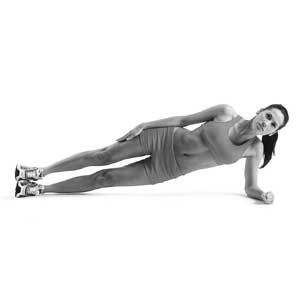Intended Audience: anyone who has not already been doing this for years
OK, OK. There is not just one perfect exercise for everyone. But this one comes close and for reasons you don’t expect. The side bridge is an exercise that is typically thrown into the category of the “core” and people think it is just done as a replacement for oblique ab crunches. While yes, it is a great replacement for that exercise it provides so much more.
The power of the side bridge extends beyond your obliques. The sidebridge influences every muscle that the obliques touch or are related to. Here are some quick facts about the side bridge exercise:
- It works your upper and lower back muscles more than 40% of their maximum. This is more than many common back exercises
- Not only does it work your obliques exceptionally well (about 50% of their maximum) it works your rectus abdominis (the sixpack muscle) very well (about 34% of its maximum). This is about the same as doing a crunch or front bridge exercise.
- The sidebridge is and excellent exercise to train a deep back muscle called the Quadratus Lumborum. The QL is an important muscle for providing stability to your spine
- The sidebridge is one of the best ways to work your hip abductor muscles. The hip abductor muscles work at about 74% of their maximum during the side bridge. This is almost double the work that this muscle does during the exercise that is most commonly prescribed for hip muscle weakness, the side lying leg raise.
Modifying the sidebridge
You can do the regular old side bridge or you can change things to make it easier or harder.
- Lift your top leg up. This increases the stress on the side of the body closest to the ground.
- Flex at the hip of the bottom leg. This puts all of the weight on your top leg and is excellent way to train your inner thighs (e.g. your hip adductor muscles). This should be an exercise for all Hockey Players
- Instead of supporting yourself from your forearms or feet you can support yourself from your knees (easier) or from you hand (easier on the muscles but harder to balance)
Why is all this important?
If you are a runner, triathlete, cyclist or swimmer than the sidebridge must be part of your conditioning program. Ideally, the sidebridge is done at a minimum of three times per week. The bridge position can be held for 3-10 seconds and then you can “roll” to the other side, hold that position and then roll back. Keep repeating this until you can’t hold your form. Rest two minutes and do it again.
The simplest rationale for the sidebridge is that it builds your muscles capacity to provide hip and trunk stability. The muscles stressed help keep your pelvis level and your spine in a strong position. This is not only important to prevent back and hip pain but is also very important in preventing knee injuries. One important aspect of knee pain is hip stability and hip abductor weakness. The sidebridge is ideal for improving stability about the hips and thus preventing or treating knee pain that has a primary cause of hip dysfunction.





Hey Greg,
Great site! I just found it via Mike Reinold’s weekly e-blast where he linked an article you wrote.
Glad to see you’re promoting yourself. You should be!!
Hope all is well
Thanks Jesse,
Keep in touch and good luck with your clinic. Let me know how things are going.
Greg
[...] Side Bridge variations - the best exercise to work the gluteus [...]